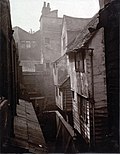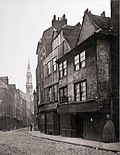
The Society for Photographing Relics of Old London was founded in 1875 in London, England, initially with the purpose of recording the Oxford Arms, a traditional galleried public house on Warwick Lane that was to be demolished as part of the redevelopment of the Old Bailey. [1] [2] [3] [4]
Contents
Alfred & John Bool took the photographs, and when the project was announced in a letter to The Times, the news received such a positive response that the society's work was continued, with a total of twelve issues being produced over twelve years, containing a total of 120 photographs. [5]
The photographs were commissioned to preserve an architectural record of buildings, some of which were built before the Great Fire of London in 1666, and which were scheduled for demolition as part of the city's urban redevelopment measures at the end of the 19th century. It was important to choose a photographic technique that would last for generations.
In 1870, the pigment printing process was invented. Society member Henry Dixon mastered the process, and the photographic images are still of excellent technical quality today. The group continued to document the old buildings of London threatened with demolition until its dissolution in 1886.







